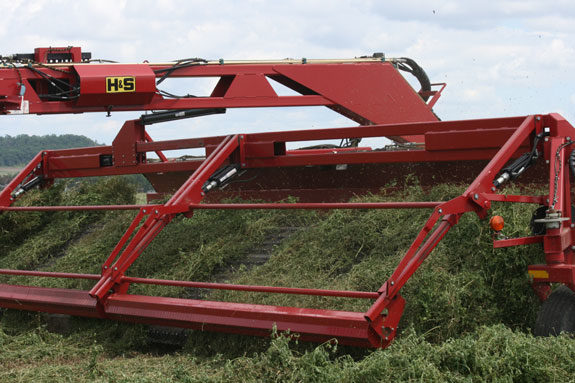Selection and operation of this equipment should be based on minimizing losses and maintaining rapid field drying which will ensure high-quality forage. How this equipment handles the swath impacts the loss and the resultant windrow condition.
Handling methods go from picking up the swath and laying it down to rolling the swath across the ground surface.
Most of the research has involved the losses and drying rates associated with these machines. In numerous cases the forage quality was evaluated with respect to the losses, usually high quality leaves, and drying rate.
In a study by Savoie et al., a parallel-bar and rotary rakes were compared in conditioned and non-conditioned alfalfa. They found no difference in the drying rate but the rotary rake had slightly higher losses.
Raking was done near 40 percent moisture, wet basis. They found tedding increased the drying rate slightly but the results were not very consistent.
During good drying conditions, tedding did not appear to be beneficial but may be beneficial after a heavy rain, which creates a windrow that was dense and matted.
In an Ohio study reported by Claas, three rakes (wheel, rotary and parallel-bar) were compared with respect to drying rate based on moisture content as forage dry down approached baling moisture.
In the first cutting for a orchard grass-alfalfa mix, the rotary rake had the lowest moisture (20.9 percent) while the wheel rake had the highest moisture (25.0 percent). The parallel-bar rake was intermediate.
For the second cutting alfalfa, the rotary rake had lower moisture (20.4 percent) than the other two rakes (22.5 percent for the parallel-bar and 23.0 percent for the wheel rake). In a third cutting of alfalfa of a orchard grass mixture, the differences in moisture between rake types were not significant.
Garthe et al. compared a parallel-bar rake with a windrow inverter and found no difference between the two devices in terms of drying rate or crop quality (based on crude protein content).
Shearer et al. compared a parallel-bar rake with two different windrow inverters. They found no difference between the three machines with respect to the drying rates or losses.
In a study of several rakes and a windrow inverter, Hoover found that the inverter and the parallel-bar rake had significantly less loss than the other rake types which included a wheel rake and several rotary rakes. In this study, the drying rate among the different rakes was very similar.
Savoie and Beauregard studied four windrow inverters that significantly increased the drying rate compared to a control with no manipulation of the forage in a windrow. In addition they indicated that an inverter could advantageously replace a hay tedder.
Although no research has been reported on windrow mergers, their losses would be expected to be similar to the windrow inverters because they both pickup the windrow and do not move it across the ground.
The drying rate of forage gathered with a windrow merger is generally not an issue because merging usually takes place right before the forage harvester.
Windrow shape and condition
To produce a consistent, high quality hay and forage, the raked or merged windrow must be uniform to ensure the moisture is uniform throughout the windrow.
Based on field experience and observations, the rotary rakes produce a more uniform and less roped windrow than wheel or parallel-bar rakes.
Windrow inverters and mergers will not produce a roped windrow but can often produce non-uniform windrow if the belt does not properly take the crop off the pick-up. In all cases, the equipment must be properly adjusted and operated to obtain the most uniform windrows.
Producing windrows free of rocks, soil, and other debris to avoid problems is important with respect to forage harvester knife wear, knife damage, clostridia fermentation (especially in high moisture silage) and excess ash content in feed.
Equipment that rolls and slides the crop across the ground will have a greater risk of rock and soil contamination in the swath. This becomes more important with high capacity forage harvesters requiring a greater distance for the crop to be moved when raking.
Machines that pickup the crop and displace it with a cross conveyor and then lay it down on the ground at another location will have less risk of contaminating the crop.
With the increased forage yields, raking and merging equipment must be sufficiently aggressive to move the large quantity of forage. Equipment that is ground driven will have greater difficulty picking up these swaths.
These would include the wheel rakes and ground driven parallel-bar rakes. PTO and hydraulic driven rakes and mergers can become more aggressive by maintaining higher operating speeds relative to the forward travel speed.
Today, forage producers have many options in equipment for moving swaths and creating swaths.
Careful selection of this equipment should be made to choose a system and machine that best meets the needs with respect to crop yield and cutting and harvesting machine size.
Also, proper adjustment and operation of these machines are important to ensure minimum losses and rapid drying. FG
References omitted due to space but are available upon request.
—Excerpts from revision of Equipment to Rake and Merge Hay and Forage, Wisconsin Forage Council
PHOTO
Photo by Darren Olsen.
Ronald T. Schuler
Extension Agricultural Engineer
University of Wisconsin










